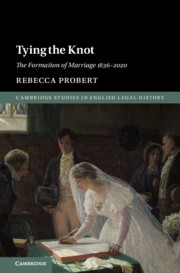Book contents
- Tying the Knot
- Cambridge Studies in English Legal History
- Tying the Knot
- Copyright page
- Dedication
- Contents
- Preface and Acknowledgements
- Abbreviations
- 1 Introduction
- 2 Conception, Design, and Implementation, 1819–1837
- 3 Reactions to the Act, 1837–1854
- 4 Amendments Enacted and Reform Deferred, 1855–1872
- 5 Differences, Divisions, and Dispensing with the Registrar, 1873–1899
- 6 Competing Conceptions of Marriage, 1900–1919
- 7 Consolidating Complexity, 1920–1949
- 8 Convergence? 1950–1993
- 9 The Rise of the Wedding, 1994–2020
- 10 The Legacy of the Past and Lessons for the Future
- Index
8 - Convergence? 1950–1993
Published online by Cambridge University Press: 10 September 2021
- Tying the Knot
- Cambridge Studies in English Legal History
- Tying the Knot
- Copyright page
- Dedication
- Contents
- Preface and Acknowledgements
- Abbreviations
- 1 Introduction
- 2 Conception, Design, and Implementation, 1819–1837
- 3 Reactions to the Act, 1837–1854
- 4 Amendments Enacted and Reform Deferred, 1855–1872
- 5 Differences, Divisions, and Dispensing with the Registrar, 1873–1899
- 6 Competing Conceptions of Marriage, 1900–1919
- 7 Consolidating Complexity, 1920–1949
- 8 Convergence? 1950–1993
- 9 The Rise of the Wedding, 1994–2020
- 10 The Legacy of the Past and Lessons for the Future
- Index
Summary
The number of religious and civil weddings gradually converged, with parity being achieved in the late 1970s. Yet those marrying in a register office did not necessarily regard marriage as a civil matter. While some were motivated by their lack of religious belief, many more did so because they were unable to marry in accordance with their beliefs. For Anglicans, it was the restrictions placed by the church on the remarriage of those who had been divorced that was the key constraint. For other denominations and faiths, it was primarily the lack of places of worship in which weddings could legally take place. Such legislative changes as did occur during this period were limited to very specific issues: new laws gave Liberal Judaism the same status as Reform Judaism, modified some of the preconditions for places of worship to be registered, enabled Anglicans and other denominations to celebrate weddings in the same building, and provided all couples with an alternative to the Anglican special licence in specific situations. More wide-ranging reform was clearly needed, but proposals to simplify the law came to nothing.
Keywords
- Type
- Chapter
- Information
- Tying the KnotThe Formation of Marriage 1836–2020, pp. 198 - 227Publisher: Cambridge University PressPrint publication year: 2021



